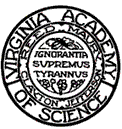
| Virginia
Journal of Science. 1999. Vol 50 (4) : 279-280 |
|
The Virginia Task Force on Pfiesteria
Robert L. O’Reilly, Chairman Virginia Task Force on Pfiesteria The Virginia Task Force on Pfiesteria is a cooperative, cohesive assemblage of the Commonwealth's natural resources and health agencies and research institutions, with supportive efforts from many other state agencies and research institutions. The task force exists to respond to Pfiesteria-related events but also monitors for Pfiesteria-related organisms and any related human health effects and lesions on finfish, In fact, other than the intensive response activities associated with Pfiesteria-related events In the Commonwealth during late August and mid-September 1997, most of the task force efforts, relative to Pfiesteria-like organisms, have been focused on monitoring (human health study participants, finfish, water and sediment), analysis (human health effects, finfish lesions), research efforts (culture and identification of heterotrophic dinoflagellates) and planning the response, monitoring and analytical activities for the future. When it was suspected that Pfiesteria might have been responsible for a modest fish kill in the Virginia portion of the Pocomoke River on August 26, 1997, the Commonwealth's task force had been in place for two months. This enabled a coordinated inter-agency response to the fish kill and effective follow-up monitoring activities by the Virginia Department of Health (VDH), Department of Environmental Quality (DEQ), Virginia Institute of Marine Science (VIMS), Old Dominion University (ODU) and the Marine Resources Commission (VMRC). Principal responsibilities established for Pfiesteria-related response and monitoring activities in 1997 continue today, even as new monitoring and response programs are initiated: The VDH is the lead agency for providing human health advisories when there are any fish with lesions or fish kills where PCOs are suspected.The VDH is the lead agency for the multi-agency effort to study Estuarine-associated Syndrome, termed the Cohort Study The
DEQ is
responsible for the field
response to any fish kill (Code of Virginia) and provides
any findings or information to the VDH, for incorporation into any
necessary news release. The DEQ also collects water and sediment
samples from the Cohort Study areas (N = 16),
in addition to monitoring 13 other sites (18 stations each month for Pfiesteria
and water
quality parameters.
VIMS utilizes
its long-standing
(since 1955) mainstem Bay and tributaries trawl survey, to
record and quantify any occurrences of lesions in (mainly juvenile)
finfish. For shallow areas
VIMS also conducts a beach seine survey. Starting in June 1998 VIMS
implemented small-mesh gill net sampling at Cohort Study sites. VIMS,
through its Aquatic Animal Disease
Diagnostic Center, is responsible for pathologies on finfish with
lesions and responds to
inquiries on fish health conditions. There are many possible causes of
lesions on finfish, and
there is not yet a certain, accurate method for linking lesions to Pfiesteria.
VIMS is
investigating the role of fungal agents in promoting lesions in
menhaden and has also initiated
the identification process for Pfiesteria-like cells, using
Scanning Electron Microscopy
(SEM).
ODU is responsible for the initial
screening for Pfiesteria-like organisms in collected water
and sediment samples from the Cohort Study (22 stations) , from
additional stations provided
by DEQ (16 stations), and from the Virginia Department of Health
Shellfish Sanitation
Division (105 stations). ODU is currently analyzing the water and
sediment samples taken
during these monitoring programs to identify Pfiesteria-like
organisms with scanning electron
microscopy. The sediment samples have also been used as an additional
source for obtaining
and subsequently culturing Pfiesteria-like cells for the purposes of
identification and
conducting toxic fish bioassays with any suspect species. Since 1984
the ODU Phytoplankton
Analysis Laboratory has also been monitoring algal blooms in Virginia,
with water samples
provided by DEQ and the Division of Shellfish Sanitation.
VMRC
served in a coordinating capacity for the task force, since it
organized the Virginia
Task Force on Pfiesteria in June 1997, until recently.
(DEQ is now the coordinating agency).
The VMRC Law Enforcement Division is responsible for maintaining any
closed area, to
water-related activities, In cooperation with DEQ, the VMRC Law
Enforcement Division
has an integral role in the Commonwealth's response to Pfiesteria-related
events
The task force is now comprised of 15 members from the five core agencies and institutions, listed above. Each participating task force member has also established a secondary contact person for the task force, in order to maintain the communication network. Other agencies and institutions which provide support to the task force efforts include the Department of Game and Inland Fisheries, Department of Conservation and Recreation, the Chesapeake Bay Local Assistance Department, Virginia Commonwealth University, Department of Agriculture and Consumer Services, Virginia Tech and the Marine Products Board. The Virginia Task Force on Pfiesteria will maintain its established, cooperative communication network in order to provide for an effective response to any Pfiesteria-related events or issues. Response and monitoring plans implemented and developed by the task force will ensure that policymakers and the public will continue to receive science-based information and advice on any Pfiesteria-related events. May 28, 1999 |